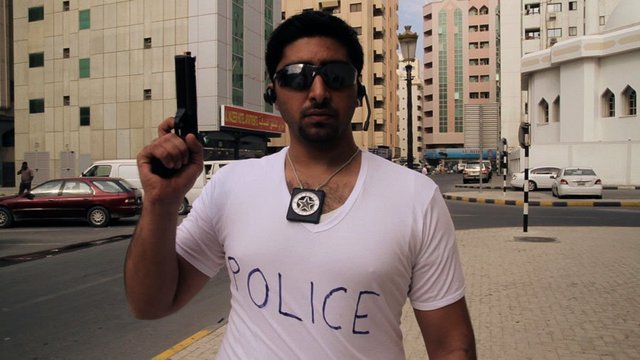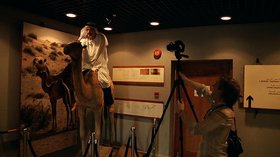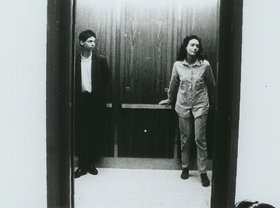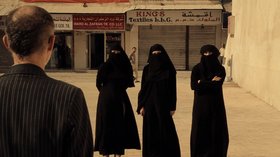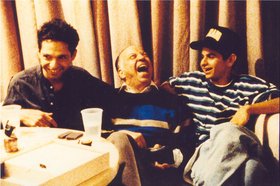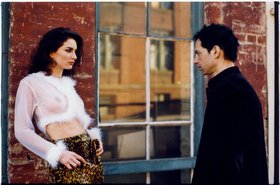Interviews
The Art of Subversion
Caveh Zahedi in conversation with Stephanie Bailey
Caveh Zahedi is an Iranian-American filmmaker whose work is positioned uncomfortably between what is acceptable and what is not. The Sheik and I (2012), the artist's most recent feature film, is also his most controversial work to date. Commissioned by the Sharjah Art Foundation as part of the 2011 Sharjah Biennial, Art as a Subversive Act, it was quickly banned precisely for its 'subversive content', unleashing a barrage of criticism – and legal battles – against the filmmaker.
Essentially a movie about a man from one culture clashing against another culture entirely, The Sheik and I is a problematic work that unflinchingly challenges the delicate lines of decorum that exist in sensitive cross-cultural interactions. Zahedi talks about the processes behind The Sheik and I in this interview, raising more questions than answers, as he reflects on the work's public reception.
Stephanie Bailey: Did you know you were going to get into trouble when you completed The Sheik and I?
Caveh Zahedi: No, I was surprised by the reaction.
SB: How many days did you spend in Sharjah?
CZ: Twenty four.
SB: And within that time you said you knew very little about Sharjah, or the UAE for that matter. What was your intention when you received this commission? I know you articulated that in your film: you wanted to just go there and make a new work. But in terms of your working process, what did you have in mind when thinking about what to produce and how?
CZ: Well, I did have a vague idea before I got there, but the film was based entirely on my experiences while I was there. I still don't have a comprehensive sense of the emirate of Sharjah really. I know people get really mad there if you do anything they consider offensive, but I can't say I came away from the experience with a particularly deep sense of the place. That said, it was never my intention to try to understand Sharjah, to create a portrait of Sharjah, or to find something particularly insightful to say about it. For me the focus was how to make a film that is going to be interesting and that's also going to take seriously the theme of the biennial, namely, 'Art as a Subversive Act'. After I left Sharjah, my concern became how to make the film I wanted to make without compromising the people in the film whose jobs could have been put at risk by my filming of them. The situation was confusing because I could never really gauge what the actual dangers were – how much of it was paranoia and how much of it was valid.
A lot of the film's critics believe that if there is even a remote chance that something unpleasant could happen to someone who appears in the film, then the film shouldn't be shown. I don't agree with that perspective politically but it's certainly a well-intentioned one. I hope the film's critics are wrong, of course, and that no one who appears in the film will be adversely affected. I spent a lot of time and effort to protect people through the settlement agreement. So far there have been no adverse repercussions. There is of course the worry of a fatwa. People have told me that my life will be in danger if I release the film. There are even journalists who are afraid of getting killed for writing about my movie. The level of hysteria is ridiculously high for something that is essentially a comedy. An American documentary programmer named Thom Powers has been trying to persuade other programmers not to show my film or write about it in the United States. He's on a crusade to blacklist my film here. The fact that people would be trying to suppress the film in the United States as well as in the UAE shows just how touchy these issues have become.
SB: In the work you literally went into this situation and embedded yourself – and those around you – within it.
CZ: The film belongs to the tradition of institutional critique. My goal was to simply hold up a mirror to the organization that commissioned it. There were progressive things that the Sharjah Art Foundation was doing and there were reactionary ones, too. There was the weirdness of them commissioning me to make a film on the theme of 'art as a subversive act' to begin with, and then their subsequent banning of the film, which was a really interesting paradox. And the fact that they weren't amused by the contradictions or even curious about the contradictions was also something I found very interesting. The curators don't see the film's merits and I think this has a lot to do with the fact that they had a specific agenda throughout the whole thing and the film uncovered and subverted that hidden agenda – namely, to give the appearance of openness and tolerance without really being open and tolerant.
SB: But weren't the people who became involved in your film the ones placed in the difficult position, and not you?
CZ: We all were put in a difficult position but, yes, in the end they were in a much more difficult position than me. This film is morally very complicated and there is a big question mark that still hovers over it.
SB: How did your previous practice inform the scope of The Sheik and I and did it lead you to this point in some way?
CZ: The Sheik and I was commissioned, which makes it ontologically different from most of my previous work. It's also more explicitly political in that it is tackling major political issues, but I think of all my work as political in the sense that the personal is always already political. One criticism that friends of mine have leveled at this film in particular is that it is not as vulnerable as my other films, where I am mostly being critical of myself. It is also more defensive than my other works. I recorded the camera address when I was still in the midst of the emotions and frustrations of dealing with that situation of having my film threatened in all kinds of ways. So I was even angrier than usual. I think if I made the film now, the tone would be more amused. That being said, the anger doesn't make the film any less of a comedy. It's just an angrier comedy and the humor is sometimes directed towards others as opposed to being only self-deprecating.
As a filmmaker, my aesthetic evolves over time, like anyone's aesthetic, and there are things in this film that come out – lessons and aesthetic concerns – that are different from the ones in my earlier works such as A Little Stiff (1991). Stiff was very much about a kind of oppositional aesthetic towards a certain kind of narrative filmmaking; It was more about playing with time and the place where narrative sort of collapses. I Don't Hate Las Vegas Anymore (1994) is more of a key film in the context of The Sheik and I. I Don't Hate Las Vegas Anymore is about my Iranian heritage and trying to fairly violently force a situation to reveal itself. A lot of it is about how far can you push, and when do you stop pushing a situation. The Sheik and I is kind of like that too. It's about pushing very hard, and, one might argue, too hard. But I don't think it's too hard. I think that is what art should do. It is supposed to push hard.
SB: At one point in The Sheik and I, you say that art should always push boundaries or expose contradictions. But what about the ethical nature of how one is to push, as in the scene where Camille Mallat of the Sharjah Art Foundation taught you how to pray in the mosque? It was really beautiful in that you are being presented the rituals of a religion, but then you have on the other side this irreverence towards the religion as portrayed by you. Did you think about the implications of respecting or disrespecting religion when approaching such scenes?
CZ: I personally think the film is very respectful to all of the people in it. To me it was a loving portrait, but more like a Picasso portrait in that you find beauty behind the distortion. I especially loved Camille. He was an incredible person and an eloquent spokesperson for everything that is great about Islam. At the same time, there are also things, I find, that are not so great about Islam. So how do you say all of it? Those people I met are all artists. There was something about them that was progressive, forward-looking and intelligent. But at the same time, and understandably, they were colluding with a certain amount of tyranny. They had no choice, in a sense: they were caught between a rock and a hard place, and they were trying their best to move things in the right direction. But let's call a spade a spade! They can't call a spade a spade because they are financially dependent on being a part of that specific environment. But I can.
For me, The Sheik and I is a document of what I would call 'reality'. I realize that 'reality' is a loaded word, but I'm using it in the way that Philip K. Dick defines it, namely, 'that which, when you stop believing in it, doesn't go away.' For me, reality is always the most important thing to respect – not religion, not culture, not agendas and not even other people's feelings. Reality trumps everything and we all need to adjust to it. Reality shouldn't have to adjust to us: that's called fantasy.
SB: In the movie, you learn how, in the Arab world, cinema is largely seen as depiction of reality and not fantasy.
CZ: I didn't understand this until towards the end of making the film. At first, the filmmaking was just a way into something. I didn't understand until Camille explained to me that, according to Islam, you really are not supposed to represent anything. I was surprised by that and found it fascinating. In the end, the film became about this ontological conflict around the relationship of representation to the sacred.
SB: You are of Iranian descent but you see yourself as an American, since you were born there. In this commission, did you feel like you were expected to play up to a different identity?
CZ: Yes, I think they expected an Iranian filmmaker, which is why they asked me to do it and also why they were surprised by how I handled it. I think any Iranian filmmaker would have known better. An Iranian would have known how to be tactful, careful, and to say things in a way that is subtle or delicate, whereas my approach is completely direct. But I think an American couldn't have made this film either. I think my being Iranian-American gave me license to actually be a bit more critical than Americans who might have been more politically correct.
SB: Thinking about I Don't Hate Las Vegas Anymore, you take your father, from whom you had been estranged, and his teenage son, on a road trip to Vegas with your film crew, and try to get them to take Ecstasy with you. What follows is a strange, off-kilter portrayal of a familial reconciliation, albeit one wrought with ethical and moral concerns, namely, whether one should take methamphetamines with one's family. But this same kind of distorted, warped sense of reconciliation feeds a certain tension in The Sheik and I: you literally begin to flail frantically within the constraints being presented to you. Did you feel a similar desire for understanding, perhaps laced with a subtle rebellion, as you were working on The Sheik and I?
CZ: Yes. All of my films in some sense act out a desire for understanding from others, and all of them are simultaneously laced with a subtle rebellion. The Sheik and I was no exception, but the real-world implications were much greater.
SB: But is it disrespectful or irreverent?
CZ: I see it as irreverent but not disrespectful. Because I'm not 100% American and because I come from a leftist background, I feel I have the right to be playful and critical at the same time. I can inhabit that contradiction, whereas a lot of people are uncomfortable with that contradiction. In the film, I don't shy away from my ineluctable status as a materialist and as a tourist and as a representative of post-colonialism; that's where my vulnerability in the film lies. But a lot of people fail to see the self-mockery and self-awareness. I mean, Americans deal a lot with the perception of 'the ugly American', and the film is an unflattering portrait of 'Americans', American audiences have been very divided about the film, too; and what is interesting to me is the extent to which it can anger or upset liberals who feel that it is morally outrageous to be disrespectful to a third world culture, given the shameful history of colonialism.
SB: There is this issue with humiliation here, something that you deal with in I am a Sex Addict (2004), a film that is essentially about repeated self-humiliation. Going back to your friends saying you were less vulnerable with The Sheik and I because your 'self' was not the sole focus of the film, in some ways could it be said that you were actually more vulnerable than ever in that you activated a very different part of yourself in a very complex situation? In some ways, you became the one doing the humiliating: the narrator who, for once at least, was not at the butt of the joke?
CZ: What's most interesting to me about the film is that I'm simultaneously the one doing the humiliating and the butt of the joke. By banning the film, the Sharjah Art Foundation demonstrated a stunning lack of any sense of humour and that lack of humour seems, to me, to be in part cultural. There is some wound in that culture that doesn't allow the aesthetic distance that humour requires, and it seems to me to be the wound of humiliation. And yet, an essential part of the dialectic of healing is to be able to laugh at oneself. By laughing at myself, I make it easier for others to laugh at themselves, too. But it's a double-edged sword.
Watch Zahedi's short film documenting the response to The Sheik and I in the United States in Ibraaz Projects, here.
Caveh Zahedi began making films while studying philosophy at Yale University. After graduation, he moved to Paris to try to raise money for a film about French poet Arthur Rimbaud, but failed to raise even one centime. Following a period in France, Zahedi applied to the film school at UCLA where he met Greg Watkins, who he collaborated with to produce A Little Stiff (1991), one of Zahedi's first film works. Currently based in New York, Zahedi is a professor of confessional cinema at the European Graduate School.
The views and opinions expressed in this interview do not necessarily reflect the views and opinions of Ibraaz.

